 |
Search the Site with

|
USS Dwight D. Eisenhower (CVN 69)
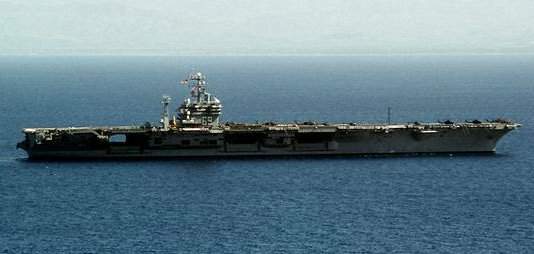
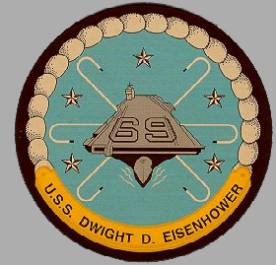
USS DWIGHT D. EISENHOWER is the second ship in the NIMITZ - class and the first ship in the Navy named after the 34th President of the United States.
| General Characteristics: | Keel Laid: August 15, 1970 |
| Launched: October 11, 1975 | |
| Commissioned: October 18, 1977 | |
| Builder: Newport News Shipbuilding Co., Newport News, Va. | |
| Propulsion system: two nuclear reactors | |
| Main Engines: four | |
| Propellers: four | |
| Blades on each Propeller: five | |
| Aircraft elevators: four | |
| Catapults: four | |
| Arresting gear cables: four | |
| Length, overall: 1,092 feet (332,85 meters) | |
| Flight Deck Width: 252 feet (76,8 meters) | |
| Area of flight deck: about 4,5 acres | |
| Beam: 134 feet (40,84 meters) | |
| Draft: 37,7 feet (11.3 meters) | |
| Displacement: approx. 97,000 tons full load | |
| Speed: 30+ knots | |
| Planes: approx. 85 | |
| Crew: Ship: 3,200 Air Wing: 2,480 | |
| Armament: two Mk-57 Mod 3 Sea Sparrow launchers, two | |
| Homeport: Norfolk, Va. |
Crew List:
This section contains the names of sailors who served aboard USS DWIGHT D. EISENHOWER. It is no official listing but contains the names of sailors who submitted their information.
- Click here to view the list.
- Click here
to see which USS DWIGHT D. EISENHOWER memorabilia are currently for sale on ebay.
USS DWIGHT D. EISENHOWER Cruise Books:
- Maiden Cruise Book 1976-78
- Mediterranean Cruise Book 1979
- Indian Ocean Cruise Book 1980
- NATO / Mediterranean Cruise Book 1981-82
- Mediterranean Cruise Book 1983
- Mediterranean Cruise Book 1984-85
- Mediterranean Cruise Book 1988
- Mediterranean Cruise Book 1990
- Mediterranean / Arabian Sea Cruise Book 1994-95
- Mediterranean / Arabian Sea Cruise Book 1998
- Mediterranean / Arabian Sea Cruise Book 2000
- Mediterranean / Arabian Sea Cruise Book 2006-07
- Mediterranean / Arabian Sea Cruise Book 2009
- Mediterranean / Arabian Sea Cruise Book 2010
- Mediterranean / Arabian Sea Cruise Book 2012-13
History of USS DWIGHT D. EISENHOWER:
Construction of the third nuclear-powered and second NIMITZ class aircraft carrier, USS DWIGHT D. EISENHOWER was authorized by Congress in fiscal year 1970.
The carrier, named after the nation's 34th president, was christened at 11:11 a.m., Oct. 11, 1975, by Mrs. Mamie Doud-Eisenhower, the ship's sponsor and widow of the late president. IKE was commissioned on Oct. 18, 1977, under the command of Capt. William E. Ramsey, USN, and assigned to the Atlantic Fleet. After 14 months of fleet training, IKE set sail for her first Mediterranean deployment.
Since that time, IKE has completed eight Mediterranean deployments. In 1980, IKE's second extended deployment tallied 254 days at sea with only a five-day stopover in Singapore.
After its fourth deployment IKE sailed into Newport News and Drydock in October 1985 for a complex overhaul. The 18-month yard period included the addition of the
In 1990, IKE completed its sixth Mediterranean Sea deployment. The deployment became a commemorative event in the worldwide 'Dwight D. Eisenhower Centennial,' celebrating the 100th anniversary of the late president's birth. During D-Day anniversary ceremonies off the coast of Normandy, IKE's son, John Eisenhower, and D-Day veterans embarked in the ship while Carrier Air Wing Seven conducted a memorial flyover of the American cemetery at Omaha Beach.
In response to Iraq's invasion of Kuwait, IKE became the first carrier to conduct sustained operations in the Red Sea. IKE was the second nuclear-powered aircraft carrier to transit the Suez canal. IKE served as a ready striking force in the event Iraq invaded Saudi Arabia, and participated in maritime interception operations in support of a United National embargo against Iraq.
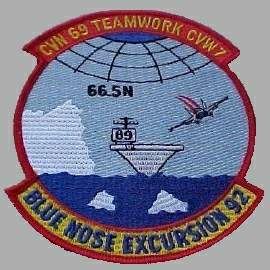 After completion of an extensive shipyard period and work ups, IKE deployed Sept. 26, 1991 to the Arabian Gulf to continue multi-national operations with coalition forces in support of Operation Desert Storm. IKE returned to Norfolk April 2, 1992. On Jan. 6, 1993, IKE entered Norfolk Naval Shipyard for overhaul and conversion, and returned to the fleet November 12, 1993.
After completion of an extensive shipyard period and work ups, IKE deployed Sept. 26, 1991 to the Arabian Gulf to continue multi-national operations with coalition forces in support of Operation Desert Storm. IKE returned to Norfolk April 2, 1992. On Jan. 6, 1993, IKE entered Norfolk Naval Shipyard for overhaul and conversion, and returned to the fleet November 12, 1993.
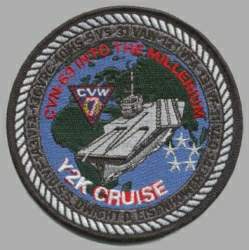 In September 1994, IKE and the U.S. Army 10th Mountain Division again made history with the concept of "adaptive force packaging." The division's soldiers and equipment were loaded on board, and the IKE Army and Navy team headed for Port-au-Prince to spearhead Operation Uphold Democracy, the U.S. - led effort to restore the democratically elected government of Haiti.
In September 1994, IKE and the U.S. Army 10th Mountain Division again made history with the concept of "adaptive force packaging." The division's soldiers and equipment were loaded on board, and the IKE Army and Navy team headed for Port-au-Prince to spearhead Operation Uphold Democracy, the U.S. - led effort to restore the democratically elected government of Haiti.
One month later, in October 1994, IKE departed for a six-month deployment which included flying missions in support of Operations Southern Watch and Deny Flight. This deployment marked the first time that women had deployed as crewmembers of a U.S. Navy combatant. The IKE, Carrier Wing Three, and COMCRUDESGRU Eight team included more than 400 women.
IKE returned to Newport News Shipbuilding on July 17, 1995, for an 18-month complex overhaul which was completed on Jan. 27, 1997. The ship departed on its 10th deployment on June 10,1998 and returned in December. In February 1999, IKE returned to the Norfolk Navy Shipyard for a six-month refitting and returned to the fleet in June. Upon completion in June 1999, she returned to full duty in the fleet.
After roughly eight months of an intensive work-up schedule, the USS DWIGHT D. EISENHOWER Carrier Battlegroup, led by IKE and Carrier Airwing Seven, headed to sea 19 February 2000 for the first Mediterranean deployment of the year 2000. After a four-month stint at Norfolk Naval Shipyards, Portsmouth, Va., the IKE crew began preparation for the deployment with four days of sea trials in June. IKE and CVW-7 participated in several strenuous at-sea operations such as the Tailored Ship's Training and Availability (TSTA) I, II and III, Competitive Training Unit Exercise (COMPTUEX) in August, the Joint Task Force Exercise (JTFEX) in December, and various exercises to qualify its naval aviators (CQ).
After roughly three days of CQ, the IKE and CAG Seven team began its transit to the Mediterranean Sea, where IKE made its first planned port call to Trieste, Italy. In addition to IKE and Carrier Air Wing Seven, some of the deploying ships were USS ANZIO (CG 68) and USS CAPE ST. GEORGE (CG 71) of Cruiser-Destroyer Group 8, USS LABOON (DDG 58), USS MAHAN (DDG 72) and USS KAUFFMAN (FFG 59) of Destroyer Squadron 26, along with USS SAMUEL B. ROBERTS (FFG 58) of Destroyer Squadron 14, USS HARTFORD (SSN 768), USS SPRINGFIELD (SSN 761), USNS KANAWHA (T-AO 196) and USNS MOUNT BAKER (T-AE 34).
On August 18, 2000, USS EISENHOWER returned to Norfolk.
On May 22, 2001, USS EISENHOWER entered Newport News Shipbuilding for her first and only refueling in her 50-year life-span.
The scope of work is valued at approximately $1.5 billion and includes the refueling of both the ship’s reactors, as well as significant modernization work. Work includes a major upgrade of the island house that will involve the shipyard removing the top two levels of the island house and replacing them. This action is driven by the installation of a new antenna mast that runs down along the island and will provide for better radar capabilities. The shipyard is also integrating a new radar tower aboard EISENHOWER.
Maintenance and repair work was performed below the ship’s waterline to include the application of a new paint system. In addition, the shipyard replaced nearly 3,000 valves and overhauling another 600 in various ship systems.
More than 3,500 Newport News Shipbuilding employees worked aboard EISENHOWER during peak periods of the overhaul and refueling project. The work was completed on November 6, 2004, and ten days later the carrier was certified ready for sea.
USS DWIGHT D. EISENHOWER Patch Gallery:
 | 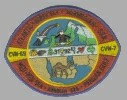 |  | 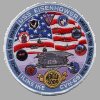 |  |
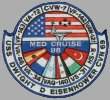 |  | Click here to view more DWIGHT D. EISENHOWER Patches. | ||
About the Carrier’s Name, about President Dwight D. Eisenhower:
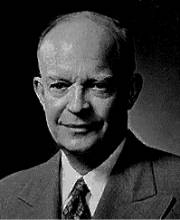 Born on Oct. 14, 1890, in Denison, Texas, Dwight David Eisenhower moved to Abilene, Kan., in 1891, where he lived until his acceptance to the United States Military Academy at West Point in 1911. Following his graduation in 1915, Ike was posted to the infantry at Fort Sam Houston, Texas, where he met Miss Mamie Doud. They were married in Denver, Colo., on July 1, 1916.
Born on Oct. 14, 1890, in Denison, Texas, Dwight David Eisenhower moved to Abilene, Kan., in 1891, where he lived until his acceptance to the United States Military Academy at West Point in 1911. Following his graduation in 1915, Ike was posted to the infantry at Fort Sam Houston, Texas, where he met Miss Mamie Doud. They were married in Denver, Colo., on July 1, 1916.
Subsequent duty assignments included attendance at the Command and General Staff School at Fort Leavenworth, Kan. in 1925-26, where he finished first in a class of 275. After graduating from the Army War College in 1928, Ike served in various capacities, including duty in the office of the Army chief of staff.
In 1935, Ike became assistant to Gen. Douglas MacArthur in the Philippines and five years later was promoted to chief of staff, Third Army. At the outset of World War II, Ike was selected to head the Operations Division of the War Department and, in 1942, was named commanding general of the European Theater.
By 1943, Allied forces under the command of Eisenhower had liberated North Africa and Sicily from the Axis and had eliminated Italy as an Axis power. President Franklin D. Roosevelt named Eisenhower as supreme commander, Allied Expeditionary Forces, and as such, Ike directed the land, sea and air invasion at Normandy on D-Day, June 6, 1944.
Ike was promoted to general of the Army in December 1944, and after accepting Germany's unconditional surrender on May 7, 1945, he was appointed commanding general, United States Forces Europe. On Nov. 19, 1945, he was named Army chief of staff, succeeding Gen. George C. Marshall. After the war, Eisenhower served as president of Columbia University and as supreme allied commander of the forces established under the NATO pact. In 1952, Ike retired from the Army and, as standard bearer for the Republican Party, easily won election to become the 34th president of the United States.
It was during President Eisenhower's administration that the Navy's nuclear shipbuilding program experienced significant growth. In the eight years of the Eisenhower administration, 29 nuclear attack submarines, the first 14 Polaris submarines, two nuclear cruisers and the first nuclear-powered aircraft carrier, USS ENTERPRISE (CVN 65), were authorized.
President Eisenhower left office on Jan. 20, 1961, after 50 years of service to his country. In March 1961, by Public Law 87-3, signed by President John F. Kennedy, Ike was returned to the active list of the regular Army with the rank of general of the Army from December 1944. He maintained his office at Gettysburg College and residence at his farm near Gettysburg, Pa., where he lived the life of an elder statesman until his death on March 28, 1969.
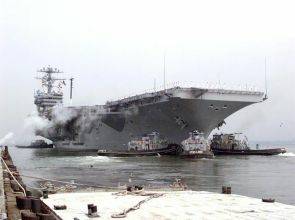
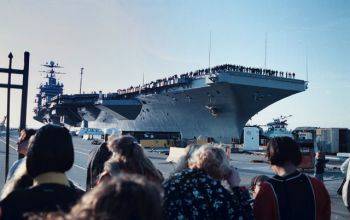
Accidents aboard USS DWIGHT D. EISENHOWER:
| Date | Where | Events |
|---|---|---|
| October 5, 1978 | An | |
| May 21, 1979 | An | |
| March 6, 1980 | An | |
| September 13, 1980 | An recover the aircraft crashed into the sea a short distance from EISENHOWER. | |
| March 6, 1982 | off Sardinia | An |
| August 29, 1988 | Hampton Roads, Va. | USS EISENHOWER collides with an anchored coal ship while entering the harbor to dock at Norfolk Naval Station when wind and current push the carrier off course. Damage is minor to both ships. |
| October 31, 1989 | 90 miles southeast of Cape Hattera, NC | A wave sweeps three sailors and 38 non-nuclear missiles from the USS EISENHOWER during night-time cargo loading. One sailor is drowned and two are rescued. |
| February 8, 1998 | near Puerto Rico | An |
| July 30, 1998 | Mediterranean | Lt. Cmdr. Ronald Lee "Rhino'' Wise Jr., 36, was killed while ejecting from his Tomcat July 30 in the Med. Three F-14s were conducting fighter crew training when two of them collided. The other Tomcat made it safely back to the EISENHOWER with minor damage. The RIO Lt. Richard Kane, 27, sustained a broken leg. They were heading for Antalya, Turkey when they decided to eject. |
| September 16, 1998 | Western Mediterranean | While conducting routine flight operations in the western Mediterranean Sea Sept. 16, an The pilot ejected safely from the aircraft and was recovered on board the EISENHOWER by an HH-60 helicopter attached to Helicopter Squadron (HS) 15. The pilot exited the helo under his own power and was evaluated by Navy medical personnel. |
| October 23, 1999 | near Puerto Rico | The crew of an F-14 was rescued from the sea after ejecting from their aircraft moments after takeoff from the EISENHOWER. Both received only minor injuries, they were assigned to VF-143. |
| October 4, 2008 | Western Atlantic | Aviation Boatswain's Mate 2nd Class Robert Lemar Robinson was killed when he was struck by the wing of a fighter jet taking off from the EISENHOWER. A memorial service was held aboard the aircraft carrier on October 8. |
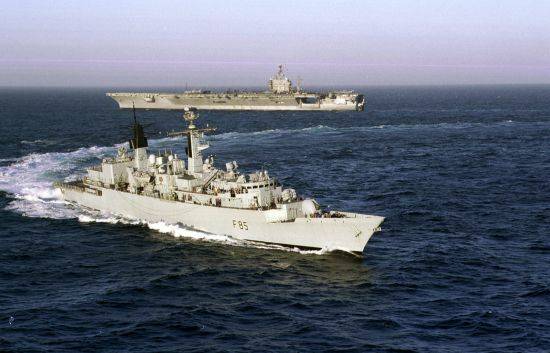
USS DWIGHT D. EISENHOWER Image Gallery:
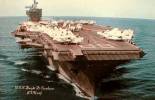 | 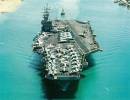 |  |  | 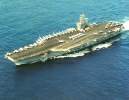 |
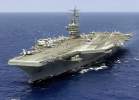 | 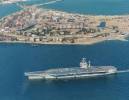 | 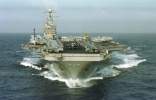 | 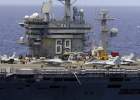 | 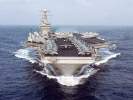 |
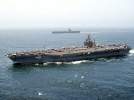 | 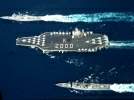 | 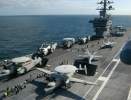 |
The photos below were taken by me on October 27, 2010, and show the DWIGHT D. EISENHOWER at the Norfolk Naval Shipyard undergoing a six-month Planned Incremental Availability to refurbish and conduct intensive maintenance on shipboard systems.
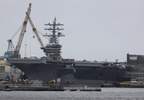 | 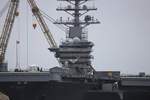 | 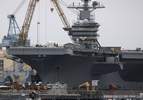 |
The photos below were taken by Michael Jenning on October 23, 2014, and show the DWIGHT D. EISENHOWER at the Norfolk Naval Shipyard undergoing a 14-month Drydocking Planned Incremental Availability (DPIA).
 | 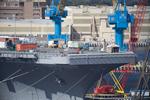 | 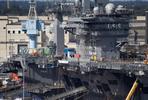 | 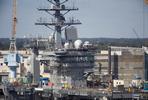 |
The photos below were taken by Steven Collingwood and show the DWIGHT D. EISENHOWER returning to Naval Base Norfolk, Va., on December 15, 2015, after completing Tailored Ship's Training Availability (TSTA) and Final Evaluation Problem (FEP) with Carrier Air Wing 3.
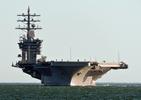
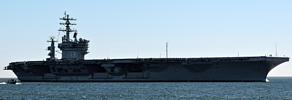
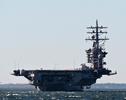
The photos below were taken by Steven Collingwood and show the DWIGHT D. EISENHOWER returning to Naval Base Norfolk, Va., on February 24, 2016, after completing a short underway as part of an INSURV inspection.
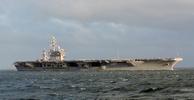

The photos below were taken by Michael Jenning and show the DWIGHT D. EISENHOWER at the Norfolk Naval Shipyard, Portsmouth, Va., on October 4, 2017. The carrier entered the shipyard on September 17, 2017, for a Planned Incremental Availability (PIA).
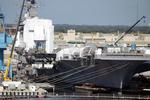 | 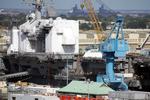 | 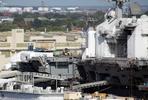 | 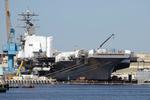 |
The photo below was taken by Michael Jenning and shows the DWIGHT D. EISENHOWER at the Norfolk Naval Shipyard, Portsmouth, Va., on September 21, 2018. The carrier entered the shipyard on September 17, 2017, for a Planned Incremental Availability (PIA).
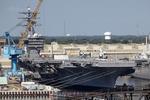 |
The photos below were taken by Michael Jenning and show the DWIGHT D. EISENHOWER during an 11-month Planned Incremental Availability (PIA) at the Norfolk Naval Shipyard, Portsmouth, Va., on December 26, 2021. The carrier entered the shipyard on August 25, 2021.
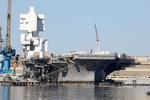 | 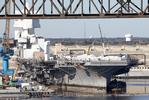 | 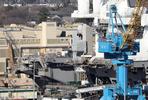 | 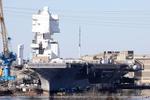 |
The photos below were taken by Michael Jenning and show the DWIGHT D. EISENHOWER at Naval Base Norfolk, Va., on October 9, 2023.
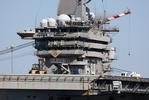 |  | 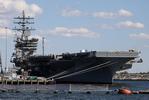 |  | 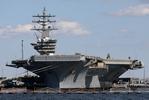 |
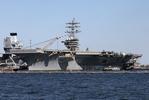 | 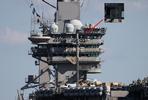 |
 Back to Carriers list.
Back to Carriers list.  Back to ships list.
Back to ships list.  Back to selection page.
Back to selection page.  Back to 1st page.
Back to 1st page.